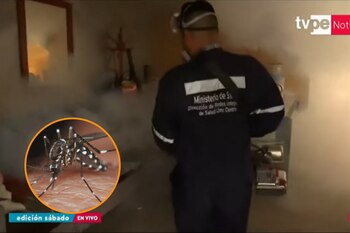

The Ministry of Health (Minsa) carried out an intervention in more than 200 homes in the district of San Juan de Lurigancho, in the Lima region. This is done in order to prevent dengue and eliminate the vector Aedes Aegypti. This came after Diris Centro had already reported four cases of dengue in this district.
Fumigation was carried out house by house in the Quebrada Castro Castro sector. These are two of the three sprays needed to prevent the spread of this disease. San Juan de Lurigancho is the only district that has reported cases of the disease in this Diris.
In total, according to the State entity, 202 houses were fumigated out of 400 in this sector. In addition, it was detected that 95% of the water tanks found in the houses had larvae.
“A total of 12 probable cases have been detected in this area. Of the 12 probable cases, we have four positive cases for dengue. Everyone is of legal age, everyone and everyone is stable to date,” said the executive director of Environmental Health, Yober Carrera.
The representative of Minsa also pointed out that in order to block the transmission of dengue, water tanks must be tightly covered, not left stagnant and, preferably, vases should not be used in homes. This last recommendation is due to the fact that vases can promote the life cycle of the mosquito that carries this disease.
“In this area there is no drinking water, so people store their water in tanks. Sometimes these tanks are not completely sealed or covered and that is where he takes advantage to enter this mosquito,” he explained.
Similarly, Carrera reported that if people have fever greater than 39 degrees, rash or muscle pain or joint pain, they should immediately go to a nearby medical center to be able to rule out dengue. If diagnosed with the disease, the health center may make the necessary referrals for care.
MORE THAN 2,000 CASES OF DENGUE IN PIURA
Authorities in the Piura region reported that cases of dengue fever are 2 thousand 472, with 5 deaths also reported. This was reported as they carry out a house-to-house discard and prevention campaign in the October 26 district.
The biologist Víctor Valdivieso pointed out that the deceased people, so far this year, had gone to a health facility untimely, so the disease progressed. In addition, they would have had some comorbidity, such as diabetes, hypertension or chronic kidney failure.
Dengue, Zica and Chikungunya are very common diseases in the northern region, during the summer season. For this reason, health personnel from the Victor Raúl facility are coming house to house to carry out discard tests and provide information on prevention. They are joined by staff from the Regional Directorate of Piura and the Municipality of 26 de Octubre.
“We are jointly carrying out the elimination of mosquito breeding, the activity of searching for febrile. We are also carrying out the stage of health education and raising awareness of the population regarding dengue disease,” said the biologist.
In addition, information will be given on the importance of house washing and permanent water change. In addition, the symptomatologies will be explained, which begin with fever, headache, joint pain, muscle pain. And in another stage, mucosal bleeding or abdominal pain may occur.